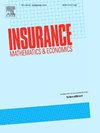Comonotonicity and Pareto optimality, with application to collaborative insurance
IF 2.2
2区 经济学
Q2 ECONOMICS
引用次数: 0
Abstract
Two by-now folkloric results in the theory of risk sharing are that (i) any feasible allocation is convex-order-dominated by a comonotonic allocation; and (ii) an allocation is Pareto optimal for the convex order if and only if it is comonotonic. Here, comonotonicity corresponds to the so-called no-sabotage condition, which aligns the interests of all parties involved. Several proofs of these two results have been provided in the literature, all based on a version of the comonotonic improvement algorithm of Landsberger and Meilijson (1994) and a limit argument based on the Martingale Convergence Theorem. However, no proof of (i) is explicit enough to allow for an easy algorithmic implementation in practice; and no proof of (ii) provides a closed-form characterization of Pareto optima. In addition, while all of the existing proofs of (i) are provided only for the case of a two-agent economy with the observation that they can be easily extended beyond two agents, such an extension is far from being trivial in the context of the algorithm of Landsberger and Meilijson (1994) and it has never been explicitly implemented. In this paper, we provide novel proofs of these foundational results. Our proof of (i) is based on the theory of majorization and an extension of a result of Lorentz and Shimogaki (1968), which allows us to provide an explicit algorithmic construction that can be easily implemented beyond the case of two agents. In addition, our proof of (ii) leads to a crisp closed-form characterization of Pareto-optimal allocations in terms of α-quantiles (mixed quantiles). An application to peer-to-peer insurance, or collaborative insurance, illustrates the relevance of these results.
协调性和帕累托最优性,适用于合作保险
在风险分担理论中,有两个至今仍是民间流传的结果:(i) 任何可行的分配都是由凸序支配的;(ii) 当且仅当一个分配是凸序时,它才是帕累托最优分配。在这里,协约性对应于所谓的无破坏条件,它使所有相关方的利益一致。文献中对这两个结果给出了多个证明,都是基于 Landsberger 和 Meilijson(1994 年)的一个版本的协整改进算法和基于马丁格尔收敛定理的极限论证。然而,第(i)点的证明都不够明确,无法在实践中轻松实现算法;第(ii)点的证明也无法提供帕累托最优点的闭式表征。此外,尽管所有现有的第①项证明都只针对双代理经济的情况,并指出它们可以很容易地扩展到双代理经济之外,但这种扩展在兰茨贝格和梅里尔森(1994)的算法中却远非易事,而且从未明确地实现过。在本文中,我们为这些基础结果提供了新的证明。我们对第(i)项的证明基于大化理论以及 Lorentz 和 Shimogaki(1968)的一个结果的扩展,这使我们能够提供一个明确的算法构造,可以轻松地在两个代理的情况下实现。此外,我们对第(ii)项的证明还导致以 α 量化(混合量化)为单位的帕累托最优分配的简明闭式表征。点对点保险或合作保险的应用说明了这些结果的相关性。
本文章由计算机程序翻译,如有差异,请以英文原文为准。
求助全文
约1分钟内获得全文
求助全文
来源期刊

Insurance Mathematics & Economics
管理科学-数学跨学科应用
CiteScore
3.40
自引率
15.80%
发文量
90
审稿时长
17.3 weeks
期刊介绍:
Insurance: Mathematics and Economics publishes leading research spanning all fields of actuarial science research. It appears six times per year and is the largest journal in actuarial science research around the world.
Insurance: Mathematics and Economics is an international academic journal that aims to strengthen the communication between individuals and groups who develop and apply research results in actuarial science. The journal feels a particular obligation to facilitate closer cooperation between those who conduct research in insurance mathematics and quantitative insurance economics, and practicing actuaries who are interested in the implementation of the results. To this purpose, Insurance: Mathematics and Economics publishes high-quality articles of broad international interest, concerned with either the theory of insurance mathematics and quantitative insurance economics or the inventive application of it, including empirical or experimental results. Articles that combine several of these aspects are particularly considered.
 求助内容:
求助内容: 应助结果提醒方式:
应助结果提醒方式:


